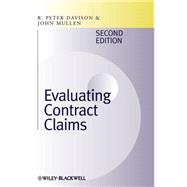
What is included with this book?
John Mullen BSc(Hons) MSc FRICS FInstCES FCIArb MAE began his training with a national firm of contractors, subsequently moving into private practice and has specialised for the last 25 years in providing consultancy services to the building and engineering construction industries. He has enjoyed over 40 appointments as an expert witness in cases at the High Court, International Chamber of Commerce arbitration, and in domestic arbitration.
| Dedication | p. v |
| Acknowledgements | p. vi |
| Preface | p. vii |
| Introduction | p. 1 |
| Risk analysis and management | p. 12 |
| Risks and records | p. 15 |
| Reimbursable risks | p. 18 |
| Non-reimbursable risks | p. 19 |
| Sources of change and disruption | p. 19 |
| Summary | p. 24 |
| Establishing the base | p. 25 |
| Planned change | p. 26 |
| Unplanned change | p. 37 |
| Summary | p. 42 |
| Effect of change on programmes of work | p. 44 |
| Use of programmes | p. 45 |
| Use of as built programmes | p. 48 |
| Change without prolongation | p. 51 |
| Prolongation of the works | p. 55 |
| Analysis of time and delay | p. 57 |
| Summary | p. 101 |
| Sources of financial information for evaluation | p. 103 |
| The contract provisions | p. 104 |
| Tender documents and information | p. 108 |
| Tender calculations and assumptions | p. 111 |
| Invoices and cost records | p. 112 |
| Accounting information | p. 116 |
| Summary | p. 119 |
| Evaluation of the direct consequences of change | p. 120 |
| Unit rates and prices | p. 122 |
| Unit costs | p. 151 |
| Subcontractor and supplier costs | p. 168 |
| Summary | p. 173 |
| Evaluation of the time consequences of change | p. 174 |
| The causal link | p. 175 |
| Prolongation | p. 179 |
| Disruption | p. 190 |
| Acceleration | p. 219 |
| Global claims | p. 225 |
| Overheads and profit | p. 234 |
| Formula approaches | p. 250 |
| Summary | p. 258 |
| Other sources of claims | p. 259 |
| Letters of intent | p. 259 |
| Termination of employment | p. 262 |
| Errors, omissions and contradictions | p. 267 |
| Fluctuations in prices | p. 271 |
| Incomplete and defective work, etc. | p. 274 |
| Summary | p. 278 |
| Minimising the consequences of change | p. 279 |
| Contract preparation | p. 282 |
| Alliance and partnering contracts | p. 284 |
| Early warning systems | p. 287 |
| The claims industry | p. 289 |
| Summary | p. 292 |
| Appendices | p. 293 |
| Example of financial accounts | p. 293 |
| Example of management accounts | p. 295 |
| Table of Cases | p. 297 |
| Index | p. 301 |
| Table of Contents provided by Ingram. All Rights Reserved. |
The New copy of this book will include any supplemental materials advertised. Please check the title of the book to determine if it should include any access cards, study guides, lab manuals, CDs, etc.
The Used, Rental and eBook copies of this book are not guaranteed to include any supplemental materials. Typically, only the book itself is included. This is true even if the title states it includes any access cards, study guides, lab manuals, CDs, etc.